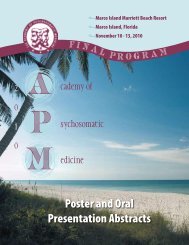Table of Contents - Academy of Psychosomatic Medicine
Table of Contents - Academy of Psychosomatic Medicine
Table of Contents - Academy of Psychosomatic Medicine
You also want an ePaper? Increase the reach of your titles
YUMPU automatically turns print PDFs into web optimized ePapers that Google loves.
50. Identification <strong>of</strong> Characteristics <strong>of</strong><br />
Providers that Influence Prescription<br />
<strong>of</strong> Analgesics for Patients With Pain: A<br />
Systematic Review <strong>of</strong> the Literature.<br />
Presenting Author: Lauren Franz, MBChB, MPH<br />
Co-Authors: Deepmala Deepmala, MBBS, Carolina Aponte<br />
Urdaneta, MD, Wei Jiang, MD<br />
Purpose: Pain is a co-morbid and aggravating symptom<br />
in many conditions which can be perceived differently, and<br />
therefore, managed differently. Numerous factors, in particular<br />
social and cultural factors, are thought to influence analgesic<br />
prescription. However, elucidation <strong>of</strong> such areas is limited.<br />
Therefore, we conducted a systematic literature review<br />
to test the hypothesis that variations in provider characteristics<br />
predict prescription <strong>of</strong> analgesics for patients with pain.<br />
Methods: A MEDLINE and Psychinfo database search from<br />
1960 to 2009 was conducted using the search terms <strong>of</strong> pain<br />
treatments, culture, ethnicity, race, gender, and physician<br />
practices. A total <strong>of</strong> 142 articles were initially identified, but<br />
only 12 articles were included in the final analysis following<br />
consensus by three independent reviewers based on inclusion<br />
criteria. For inclusion the studies needed to contain information<br />
on both provider demographic characteristics and<br />
analgesic prescription practices for pain in the analysis section<br />
<strong>of</strong> the paper.<br />
Results: Of the 12 studies, all were cross-sectional in design,<br />
and 10 used a survey instrument to measure quantitative<br />
responses. A randomized sampling methodology was<br />
used in 5 <strong>of</strong> the studies and a convenience sample was used<br />
in 4. A great heterogeneity existed among all the studies in<br />
terms <strong>of</strong> population, and purpose. A total <strong>of</strong> 3531 providers<br />
were identified among the 11 studies that presented data.<br />
The majority <strong>of</strong> providers who participated in these studies<br />
were male (64.9% in 8 studies that presented data), Caucasian<br />
(73.5% in 5 studies), internal medicine physicians and<br />
primary care providers (65.25% in 10 studies) and located<br />
in the United States (75% across all 12 studies). Of the 12<br />
studies 10 identified at least one provider characteristic that<br />
influenced prescription practices. Age, level <strong>of</strong> experience,<br />
and gender were listed most frequently as contributing factors.<br />
The interplay between the gender <strong>of</strong> providers and patient<br />
characteristics appeared to be an important variable in<br />
pain management as well.<br />
Conclusions: Our systematic review <strong>of</strong> existing literature<br />
highlights that a provider’s age, gender, experience, specialty<br />
and the interplay between provider and patient characteristics<br />
are important variables in pain management. We also<br />
found lacunae in the literature on the influence <strong>of</strong> physician’s<br />
ethnicity or primary medical training in various cultures or<br />
global regions on pain management practices. A homogeneity<br />
<strong>of</strong> provider pr<strong>of</strong>iles was noted, which limits generalizability<br />
<strong>of</strong> data from these studies. A systematic approach to evaluate<br />
the influence <strong>of</strong> provider’s characteristics on pain management<br />
is essential and imperative.<br />
21<br />
51. Encephalitis Associated with NMDA<br />
Receptor Antibodies<br />
Presenting Author: Abdul Khalid, MD<br />
Co-Author: David Straker, DO<br />
Background: Paraneoplastic encephalitis associated with<br />
N-methyl-D-aspartate receptor antibodies is a rare syndrome<br />
that should be considered in the differential diagnosis <strong>of</strong> a<br />
young, female patient with no prior psychiatric history who<br />
has a sudden change in mental status, exhibits bizarre behavior,<br />
and has prominent psychiatric symptoms accompanied<br />
by seizures, autonomic instability, hypoventilation and<br />
dyskinesias.<br />
Objective: The authors hope to increase the awareness <strong>of</strong><br />
such a syndrome as demonstrated in the case presented.<br />
Method: The authors report on a 20 year old previously<br />
healthy female with no past psychiatric history who presented<br />
with a sudden onset <strong>of</strong> change in behavior, mutism, agitation,<br />
staring spells, and dis-inhibited behavior, accompanied<br />
by seizures, hyperthermia and prominent autonomic instability.<br />
She also had muscle rigidity, frequent facial grimacing<br />
and kicking motions <strong>of</strong> the legs.<br />
Results: The patient was treated with anticonvulsant medication<br />
to control her seizures. She was then placed on high<br />
dose steroids with small improvement noted. Subsequently<br />
a vas cath was placed for plasmapheresis. IVIG was given<br />
and by Day 3 the patient was much more interactive with<br />
significant overall improvement by Day 5. The patient was<br />
discharged 3 days later. Two months after discharge the<br />
patient’s family reported that she was back to her baseline<br />
functioning.<br />
Conclusion: Paraneoplastic anti-NMDA receptor encephalitis<br />
is a potentially lethal syndrome, but is usually reversible<br />
if promptly recognized and treated. Early recognition and<br />
awareness can lead to appropriate treatment and resolution<br />
<strong>of</strong> symptoms.<br />
52. Disordered Eating in Schizophrenia and<br />
Superior Mesenteric Artery Syndrome - A<br />
<strong>Psychosomatic</strong> Case Study<br />
Presenting Author: Khyati Brahmbhatt, MD<br />
Co-Author: Geraldine Mayor, MD<br />
Purpose: The purpose <strong>of</strong> this poster is to analyze the relation<br />
between psychosis and disordered eating, demonstrate<br />
the relation <strong>of</strong> disordered eating to Superior Mesenteric Artery<br />
Syndrome (SMAS) and appreciate Confounding effects<br />
<strong>of</strong> Psychiatric diagnosis on medical care using a clinical case<br />
report.<br />
Methodology: Case report<br />
Introduction: SMAS is a form <strong>of</strong> upper intestinal obstruction<br />
caused by compression <strong>of</strong> the third part <strong>of</strong> the duodenum by<br />
the superior mesenteric artery due to loss <strong>of</strong> peritoneal fat.<br />
Most cases in psychiatry are related to Anorexia Nervosa.



